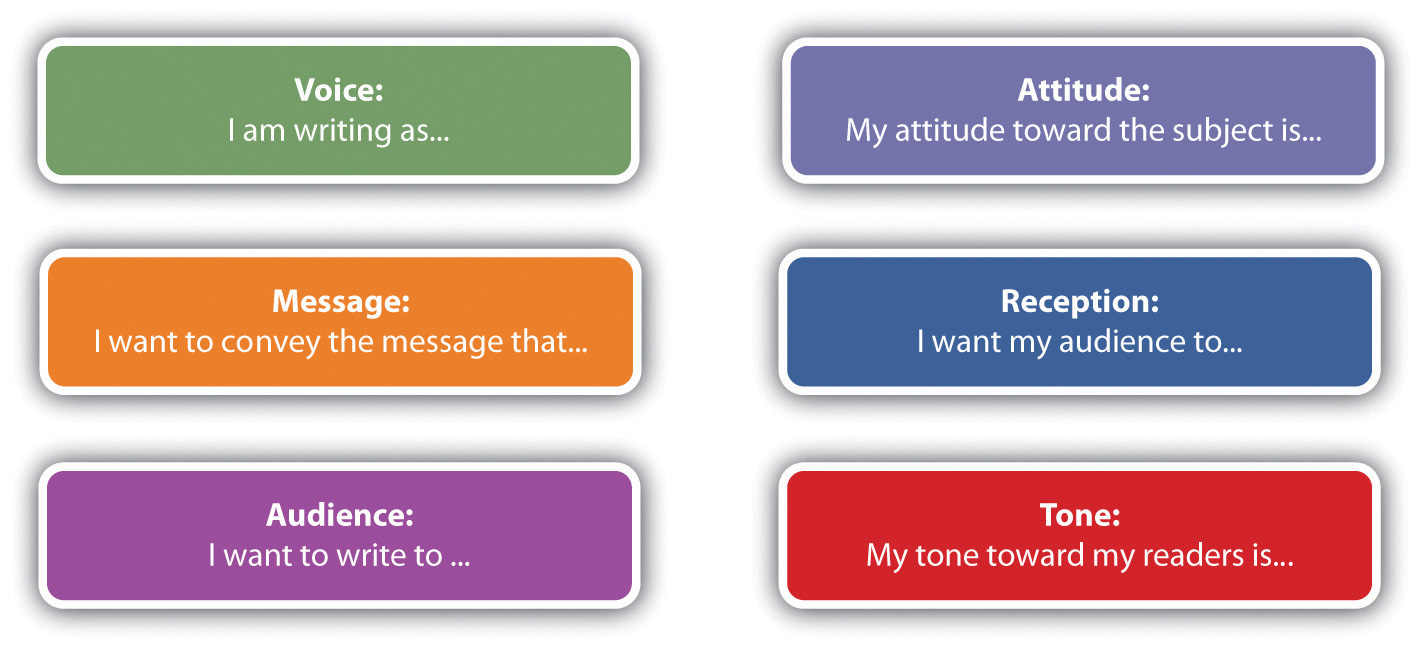After you have settled on a specific writing topic, it’s time to return to some of the basic principles of rhetoric introduced in Chapter 4 "Joining the Conversation" so that you can think through your real purposes for writing and explore the key details of your rhetorical situation. This section will show you how to use both the corners and the sides of the rhetorical triangle as tools for thinking, planning, and writing. Notice how these choices you make about purpose, message, audience, and voice are never made in isolation.
PurposeThe sum total of what a writer intends to accomplish.: You may think that purpose can be boiled down to one of these single verbs or phrases:
However, your real purposes for writing are really more complicated, interesting, and dynamic than this simple list. Purpose involves all three sides and all three corners of the rhetorical triangle: not only do you want to make your audience feel or think a certain way about your message, but you also want to explore and refine your own thoughts and feelings about that message, and furthermore, you want to establish a certain kind of relationship with your audience through the act of conveying your message to them.
Once you have identified your purposes and the corners of the rhetorical triangle, it’s time to do some preliminary thinking about the relationships between those corners—that is, the sides: voice and message (attitude), message and audience (reception), and voice and audience (tone). Finish the sentences below.
Figure 5.2 Your Rhetorical Situation

Near the beginning of the writing project, you could write up a preliminary statement of purposeA preliminary tool for developing your purposes for a writing project, specifically your message, audience, voice, attitude, reception, and tone. based on how you complete these sentences and use it as a strategy memo of sorts:
| Voice | I am writing as a person unfamiliar with South Dakota culture who has been assigned the task of writing about it. |
| Message | I want to convey the message that the Sturgis Motorcycle Rally is an interesting phenomenon of popular culture. |
| Audience | I want to write to my teacher and the other members of my writing group. |
| Attitude | My attitude toward the subject is pretty neutral right now, bordering on bored, until I find out more about the topic. |
| Reception | I want my audience to know that I know how to research and write about any topic thrown at me. |
| Tone | My tone toward my readers is semiformal, fairly objective, like a reporter, journalist, or anthropologist. |
Because all the elements of the triangle are related to each other, all are subject to change when the direction of your work changes, so be open to the idea of returning to these questions several times over the course of your writing project. When you are ready to turn in your project, revise your preliminary statement of purpose into a final version, or writer’s memoA method of presenting, packaging, reflecting on, and commenting on one’s own writing project, specifically its message, audience, voice, attitude, reception, and tone., as a way of presenting and packaging your project, especially if your instructor invites such reflection and commentary.
Here’s an example of a writer’s memo submitted with the Sturgis Motorcycle Rally essay:
| Voice | I am writing as a kind of social historian and observer of a specific example of popular culture. |
| Message | I want to convey the message that the Sturgis Motorcycle Rally has become an important part of the identity of Sturgis and the surrounding area. |
| Audience | I want to write to my instructor and classmates—but also to the citizens of Sturgis, South Dakota. |
| Attitude | My attitude toward the subject is neutral to positive. In general I think the rally has been good for Sturgis over the years. |
| Reception | I want my audience to understand and appreciate Sturgis Motorcycle Rally, and maybe to think about how something like it could work well in our community. |
| Tone | My tone toward my readers will be informal but informative, and occasionally humorous, to fit the craziness of Sturgis Motorcycle Rally. |